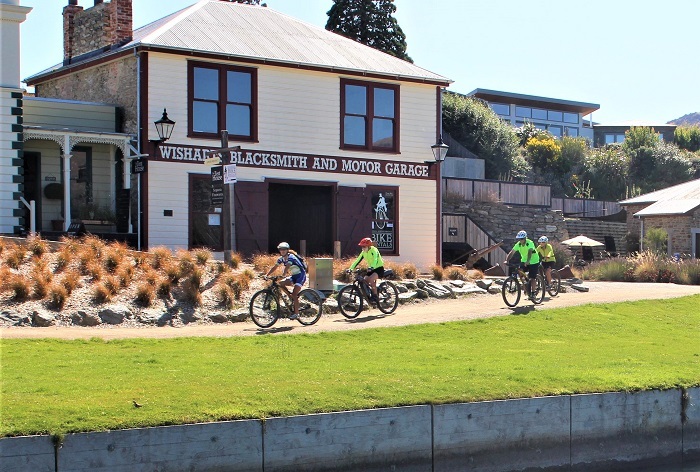Replacing tourists with visitors - Central has a plan
Jill Herron
23 August 2022, 6:18 PM
 Tourism Central Otago general manager Dylan Rushbrook (right) and digital marketer Anthony Longman are excited to be launching a “transformative” new plan for local tourism
Tourism Central Otago general manager Dylan Rushbrook (right) and digital marketer Anthony Longman are excited to be launching a “transformative” new plan for local tourismThey’re not called tourists anymore, they are visitors who come to Central Otago as an extension to our community, according to a new plan for Central’s tourism.
The tourism industry is changing nationwide as well as globally and in Central Otago the idea is to get ahead of the crowd.
A lot of money and time has been invested in producing the district’s new Destination Management Plan, which sets out a new way of doing things for the industry.
The plan, due to be released on Friday, is one of 31 such plans being created by regional tourism organisations nationwide.
They are funded by central government and aim to give the way Kiwis think about and manage the industry a thorough post-Covid, environmental, and social make-over.
The idea was to better balance out the benefits of tourism with the inevitable burdens, Tourism Central Otago’s (TCO) Anthony Longman says.
These burdens could include pressure on roads, services, communities, and the environment.
Acknowledging Māori history and culture and changing the whole focus to attracting visitors who might be inclined to contribute to the place, rather than just “take”, were at the heart of the plan.
A greater focus on managing, and less on marketing, was also central to the work.
Aspirations for short and longer-term tourism management have been created, from a 12-month plan to 10-year plans, with a view right out to how the industry will evolve over 50 years.
TCO general manager Dylan Rushbrook says Central Otago was well placed to make the “significant mindset shift” across its tourism industry, with the type of visitors already coming here being largely those who appreciated and respected the natural environment.
“In the past communities have been required to serve tourism. What we’re trying to do is flip that around and so actually it’s now tourism that’s going to be serving the community.”
Dylan said it was important for visitors to understand what Central Otago’s values were and to engage with local people.

Domestic visitors on wheels fit in well with the way we like to do tourism in Central Otago, according to a new plan
Cyclists (seen as holding huge potential as beneficial visitors for the area) tended to travel at a leisurely pace, visit small local businesses and interact with residents.
Plan of action
Ideas mooted include a ‘talent lab’ to educate young people entering the industry, partnerships with organisations working in areas like native plant restoration, and the development of a pledge visitors might sign or agree to, regarding how they will give back to the area.
Ideas would be developed on incorporating Māori history and culture into people’s experience of Central Otago and enhancing everyone’s understanding of it, be they international or domestic visitors or local residents.
A closer working relationship with neighbouring areas is also being further cemented to allow knowledge to be exchanged on things like developing a new cycle trail and all that goes with that, Dylan said.
How the work will be implemented was the immediate priority with a new governance group soon to be appointed. An existing tourism advisory board would be dissolved, and he hoped some of those members would move over to the new group.
The plan is broken into nine sections and includes statements of ambition and challenge, values, strategies and key performance indicators for long term planning. It also contains 80 pages of results from a community engagement survey.
It has been over 18 months in the making with Dylan and Anthony devoting around 30 to 40 per cent of their time to it. The plan was developed in partnership with consultancy Aukaha to ensure all aspects of Māori history and culture were incorporated.
Considerable industry research was undertaken and a plethora of groups, individuals and businesses contributed to the document through workshops, planning and surveys.
Central government, through the Ministry of Business, Innovation and Employment (MBIE) funded $125,000 for Angus & Associates as lead consultants on the plan, $17,000 for Aukaha, and $110,000 for various research work.
TCO has received $1M from MBIE overall, through its recent Tourism Communities: Support, Recovery and Re-Set Plan programme, according to MBIE’s website.
The organisation, which is part of the Central Otago District Council (CODC) will use the government funding for the first 12 months of implementation of the plan, estimated to be between $200,000 and $300,000.
CODC elected members were advised ongoing costs of $250,000 to $300,000 per annum would be required to keep the work going, and in addition an allowance of $70,000 every five years would be needed for a “refresh” of the plan and research, according to a statement from CODC.
Council will not be making a decision on this until next year, as part of the Annual Plan adoption process for 2023 and 2024. This would enable staff time to explore alternative funding mechanisms.




